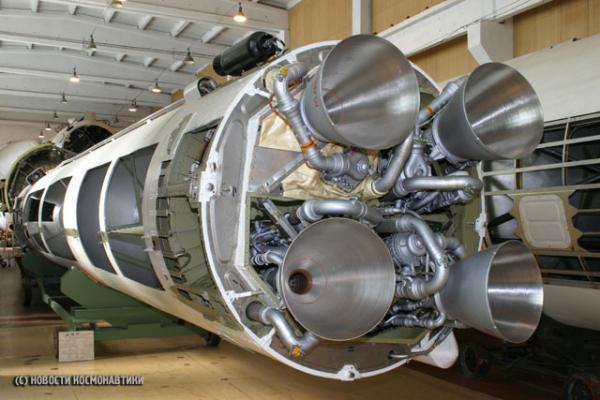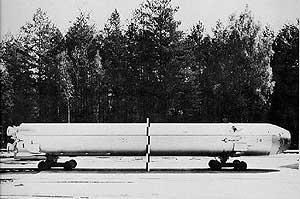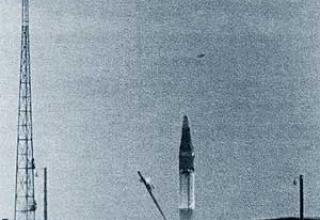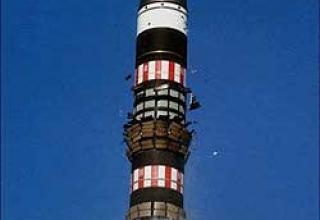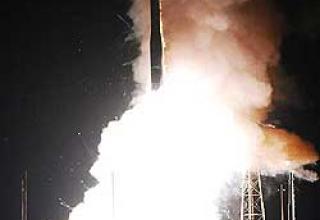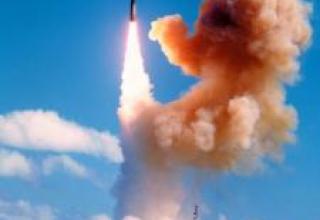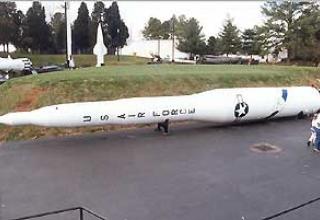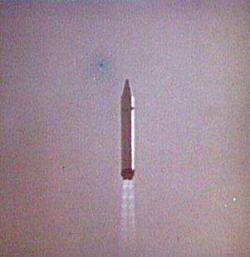
The development of the 8K84 intercontinental ballistic missile was started at the Central Mechanical Engineering Design Bureau under the leadership of V.N.Chelomey in accordance with the Decree of the CPSU Central Committee and the USSR Council of Ministers of March 30, 1963. The 8K84 missile was created in response to the American project "Minuteman-1". The 8K84 ICBM was to be suitable for high-volume construction, to be placed in single launch silos with remote control launch, to have a guaranteed service life of at least five years and to maintain high alert throughout its entire life.
The first 8K84 launches under the flight and design testing program at Baikonur range were carried out from the ground launcher. In 1964 the construction of the OS control system began. Ten mines 32 meters deep and one command post were built for testing at the range. The first launch from the ground control unit was held on April 19, 1965, the first launch from the SHPU - July 17, 1965. A total of 60 launches were made under the LKI program. Tests were completed on October 27, 1966. On November 24, 1966 the first regiments with 8K84 ICBMs were put on combat duty in the NSR under the settlements of Drovyanaya, Chita Region, Bershet, Perm Region, Tatishchevo, Saratov Region, and Gladkaya, Krasnoyarsk Territory. The 8K84 missile complex was adopted by Resolution SM 705-235 of July 21, 1967.
In 1964, the Khrunichev Moscow Machine-Building Plant began producing missiles. Series 8K84 was also deployed at Omsk Aviation Plant № 166 (PO "Flight") and Orenburg Aviation Plant № 47 (PO "Arrow").
Initially, V.N.Chelomey intended to use 8K84 missile in ICBM variants, anti-missile and ballistic missiles for submarines and surface ships. The Taran missile system project using 8K84 was closed in 1964. The project of the sea version of UR-100M was developed in 1963-1964 and was not implemented either.
The "light" 8K84 ICBMs along with the "heavy" 8K67s made it possible to achieve quantitative parity with the United States in the 1960s. These missiles could be on duty in a fueled state, which made it possible to keep them almost permanently on high alert. The deployment of the missiles was characterized by a very high rate. By the end of 1969, about 860 8K84 missiles and 170 8K67 missiles were deployed. By 1971, the number of deployed 8K67s was 260, and 8K84s were 990. In addition, the first Soviet 8K98 solid-fuel intercontinental missile was adopted for service in 1968. This missile was put on combat duty, but its deployment was limited to 60 launchers.
Modernization of the 8K84 missile resulted in the development of the 8K84M ICBM with an improved control system and enhanced tactical and technical characteristics. The flight and development testing of the upgraded missile at Baikonur was completed in 1971 after twelve successful test launches. The complex was adopted for service on October 3, 1972. Refinement was carried out directly in the 8K84 ICBM silo launchers at the starting positions of the position areas. In 1974 8K84 was taken out of service. It was replaced by more advanced missiles with enhanced tactical and technical characteristics and combat capabilities of the new generation, including: 15A20, 15A30/15A35, 15A15 and others.
Composition:
8K84 was made in tandem scheme with sequential step separation and tight layout of compartments. The missile structurally consisted of the first and second stages and the head part.
The body of the first 8C816 soup chamber housed: four 15D2 (RD-0217) marching liquid propellants with rotary nozzles, pneumatic-hydraulic system, tank emptying system and control system devices. The body was made on the bearing scheme and consisted of three compartments: tail, fuel and front. The fuel compartment, made of aluminum alloy AMG-6, was an integral unit, consisting of an oxidizer tank and fuel tank, which were separated by a common combined double bottom. The engine unit of the first stage was made on the closed circuit with afterburning of generator gas in combustion chambers. The high specific thrust impulse of the engines allowed reducing the time of the first stage operation. Their total draught on the ground reached 74 tons. To control the flight of the rocket, each engine was deflected in one plane by the hydraulic steering.
The second stage 8C817 was similar in design to the first stage and consisted of the tail, fuel and instrument compartments. It was equipped with a single-chamber marching LCD 15D13 and four-chamber rocket steering engine 15D14 (RK-3). The second stage engines were developed at the Leningrad Design Bureau-117 (Chief Designer S.P. Izotov). They developed thrust in the void 13.4 tons and 1.5 tons respectively and provided a flight speed of 7.12 km / s at the end of the active section. Nitrogen tetroxide and unsymmetric dimethylhydrazine were used as fuel components. All tanks were inflated with compressed nitrogen and air from the cylinders installed in the mine launcher before the start, and in flight the inflated tanks were carried out with gas generation products. Separation of rocket stages was carried out with the help of powder rocket engines installed in the tail compartment of the first stage.
The rocket was equipped with an autonomous inertial control system, which provided flight control at the active section of the trajectory in accordance with a predetermined flight program, and also provided automated preparation of the launch and launch of the rocket, remote continuous and periodic monitoring of the rocket from the control station of the combat missile system. It consisted of devices installed both in the instrument compartment and on the launcher.
The 1Mt head unit was developed at the Research Institute-1011 (Chelyabinsk-70, now the Russian Federal Nuclear Center - All-Russian Research Institute of Technical Physics, Snezhinsk, Chelyabinsk Region). E.N.Zababakhin, B.V.Litvinov, A.D.Zaharenkov, O.N.Tihane were the scientific leaders of the work.
In the 8K84M version, the missile was one of the first ICBMs equipped with a missile defense system. Its ABM system was developed at NII-108 under the leadership of Vitaly Gerasimenko and was named "Palma".
The rocket was ampulsified (isolated from the environment) in a special transport and launch container (TPC) filled with inert gas. In the TPC it was transported, stored in the mine start-up unit during the whole period of operation in constant readiness for start-up and started from it. The use of diaphragm valves that separated the fuel tanks with aggressive components from the rocket engines made it possible to keep the rocket permanently filled for several years. Control of the technical condition of the missiles of one combat missile complex, as well as prelaunch preparation and launch, was carried out remotely by commands from the regimental command post. The transport and launch container was designed at Branch No. 2 of the Design Bureau-52 (now the State Research Institute "Design Bureau Vympel") under the supervision of Chief Designer V.M.Baryshev. TPK with diameter of 2.7m, length of 19.5m and weight of 14.4t was sealed with special film.
The starter complex was created in the General Engineering Design Bureau (GEM) under the supervision of V.P.Barmin. The autonomous control system was developed at the Research Institute of Automobile Building under the leadership of N.A.Pilyugin. The command devices were developed in Research Institute-944 under the supervision of Victor Kuznetsov.
The launch complex for the 8K84 missile consisted of 10 dispersed combat launch positions, each of which housed one 15P784 silo launcher. Near one of the combat launch positions there was a command post of the combat missile system connected by cable lines of the combat control system and communication with all the launch positions. From the command post, the technical condition of the missile, launcher systems and missile launch control systems were continuously and periodically monitored. The prelaunch preparation was carried out automatically from autonomous power sources. The missiles were in the control gear only in the fueled state. It was planned to carry out maintenance of the launcher at least once a year with the involvement of combat calculation and mobile means of the position area. The launcher and the missiles were on combat duty and the missiles were launched without the presence of a combat calculation.
The launcher was a structure consisting of a shaft and a headband closed from above by a protective device roof. It housed the technological equipment and special technical systems, providing long maintenance, preparation for launch and launch of the rocket. The following equipment was placed in the shaft of the mine: the launch device, elements for connecting cable and gas communications with the rocket, elements of the gas exhaust path, ground water pumping facilities and other equipment. Equipment for preparing the rocket for launch and its launch, elements of the remote control and management system, special current power supply equipment, means of compressed gas supply to the rocket and other equipment were placed in the head of the launch facility. The mine withstood a pressure of up to 2 kg/cm2, which is equivalent to the energy of an explosion of a megaton nuclear warhead produced at a distance of 1,300 metres. The launch method is gas-dynamic.
The defensive device and the installer were developed at the Central Design Bureau of Machines and Equipment under the leadership of Nikolai Krivoshein. The protective device for the slide control had an opening time of 30 seconds and was designed as a sliding reinforced concrete slab located on inclined rails. The installer was designed for craneless loading of the container with the rocket into the mine structure and installation on the launching device.
Characteristics:
| Maximum range of fire, km: | 10600 |
| The length of the rocket, m | 16,93 |
| Maximum housing diameter, m | 2 |
| Start mass, t | 41,4-42,3 |
| First-stage marching engine traction by the ground, shh. | 80 |
| First-stage marching engine traction in the void, shh. | 87 |
| Specific traction pulse of the first stage marshal engine at ground level, kgf/kg | 274 |
| Specific traction pulse of the first stage marshal engine in the void, kgc/kg | 306 |
| Specific traction pulse for second stage marshal engine, kgf/kg | 320 |
| Shooting accuracy (CWO), m | 1000-1400 |
Testing:
In the mid-1960s, in order to study the impact of aggressive propellant components on the missile during its long-term operation, on the initiative of V.N.Chelomey at the test base in Faustovo were built two mine launchers for missiles 8K84. One of the silos was manufactured in the standard version and was intended for research of the standard missile during the entire warranty period of its storage. This mine also contained more than 1000 samples of materials - metals, non-metals, rubber goods, adhesive and welded joints of various shapes and combinations, radio equipment, pumps, batteries and much more. In addition to the employees of OKB-52 more than 100 related enterprises participated in the research of materials resistance to long-term storage. Simultaneously, several times a day for the duration of many years of storage about 100 parameters (temperature, humidity, gas content, pressure in tanks, etc.) were registered. The second mine was also designed for the 8K84 missile. The rocket installed in it was filled with aggressive components and stored at a temperature of + 50 degrees for accelerated corrosion tests within one year. During the experiments, no serious malfunctions or failures of rocket systems were detected in any of the mines. The results of these tests extended the warranty period for subsequent modifications to 15 years, then to 20 years, then to 25 years.
Sources:
- "Стратегические ядерные силы. Оружие и технологии России" Том 1
- Карпенко А.В., Уткин А.Ф., Попов А.Д. "Отечественные стратегические ракетные комплексы". СПб, Невский бастион-Гангут 1999 год.
- «Трижды орденоносный - отечеству»
- Демонстрационный зал филиала МГТУ им. Н.Баумана в Орево Дмитровского р-на, М.О. /"Новости космонавтики".
- Межконтинентальная баллистическая ракета УР-100
- Ракетные комплексы ракетных войск стратегического назначения aviarus-21.com
- UR-100
- UR-100 / SS-11 SEGO www.fas.org
